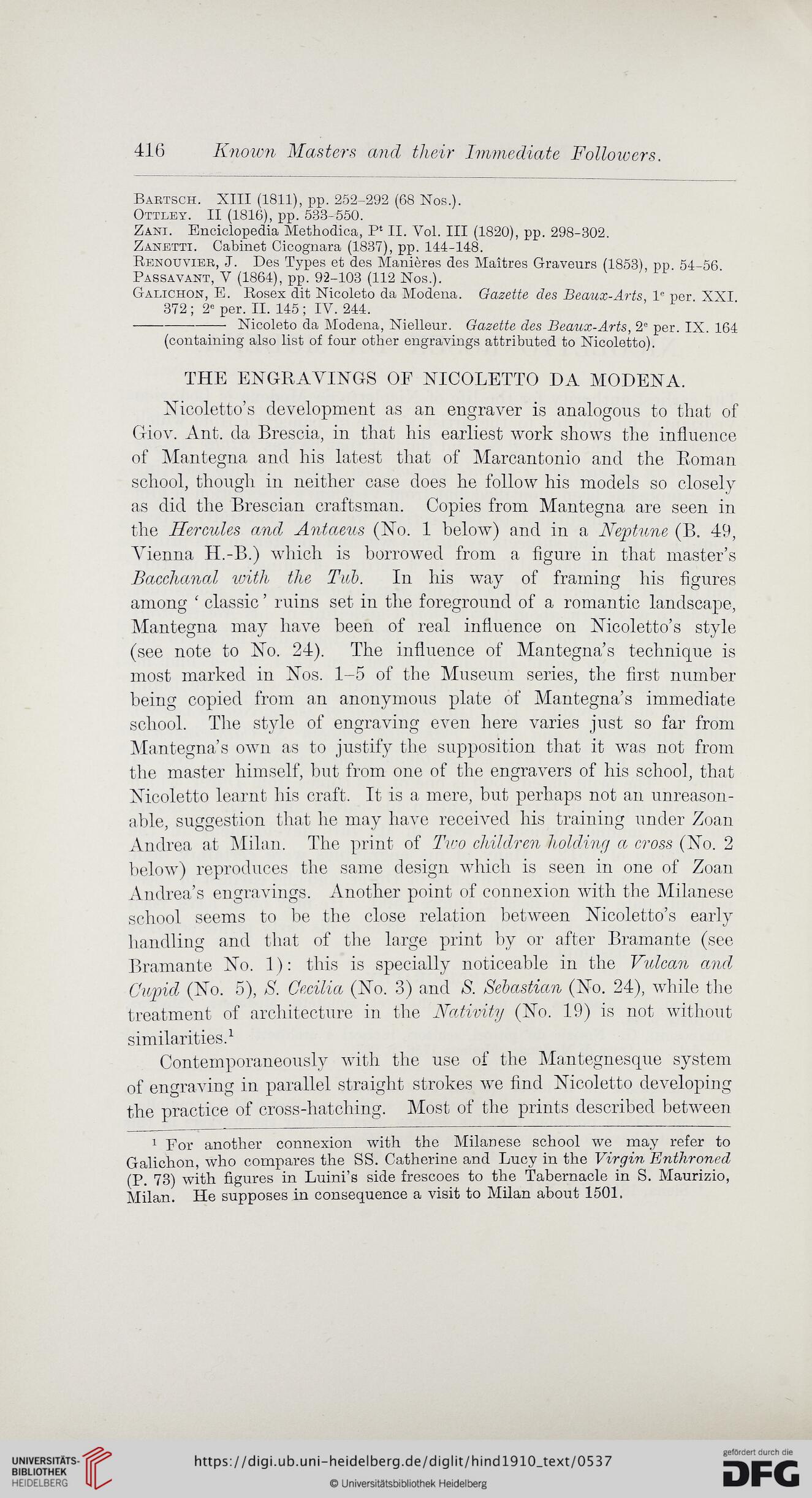416 Known Masters and their Immediate Followers.
Bartsch. XIII (1811), pp. 252-292 (68 Nos.).
Ottley. II (1816), pp. 533-550.
Zani. Enciclopedia Methodica, P‘ II. Vol. Ill (1820), pp. 298-302.
Zanetti. Cabinet Cicognara (1837), pp. 144-148.
Renouvier, J. Des Types et des Manieres des Maitres Graveurs (1853), pp. 54-56.
Passavant, V (1864), pp. 92-103 (112 Nos.).
Galichon, E. Rosex dit Nicoleto da Modena. Gazette des Beaux-Arts, le per. XXI.
372; 2® per. II. 145 ; IV. 244.
---- Nicoleto da Modena, Nielleur. Gazette des Beaux-Arts, 2e per. IX. 164
(containing also list of four other engravings attributed to Nicoletto).
THE ENGRAVINGS OF NICOLETTO DA MODENA.
Nicoletto’s development as an engraver is analogous to that of
Giov. Ant. da Brescia, in that his earliest work shows the inssuence
of Mantegna and his latest that of Marcantonio and the Roman
school, though in neither case does he follow his models so closely
as did the Brescian craftsman. Copies from Mantegna are seen in
the Hercules and Antaeus (No. 1 below) and in a Neptune (B. 49,
Vienna H.-B.) which is borrowed from a figure in that master’s
Bacchanal with the Tub. In his way of framing his figures
among ‘ classic ’ ruins set in the foreground of a romantic landscape,
Mantegna may have been of real inssuence on Nicolette’s style
(see note to No. 24). The inssuence of Mantegna’s technique is
most marked in Nos. 1-5 of the Museum series, the first number
being copied from an anonymous plate of Mantegna’s immediate
school. The style of engraving even here varies just so far from
Mantegna’s own as to justify the supposition that it was not from
the master himself, but from one of the engravers of his school, that
Nicoletto learnt his craft. It is a mere, but perhaps not an unreason-
able, suggestion that he may have received his training under Zoan
Andrea at Milan. The print of Two children holding a cross (No. 2
below) reproduces the same design which is seen in one of Zoan
Andrea’s engravings. Another point of connexion with the Milanese
school seems to be the close relation between Nicoletto’s early
handling and that of the large print by or after Bramante (see
Bramante No. 1): this is specially noticeable in the Vulcan and
Cupid (No. 5), S. Cecilia (No. 3) and N Sebastian (No. 24), while the
treatment of architecture in the Nativity (No. 19) is not without
similarities.1
Contemporaneously with the use of the Mantegnesque system
of engraving in parallel straight strokes we find Nicoletto developing
the practice of cross-hatching. Most of the prints described between
1 For another connexion with the Milanese school we may refer to
Galichon, who compares the SS. Catherine and Lucy in the Virgin Enthroned
(P. 73) with figures in Luini’s side frescoes to the Tabernacle in S. Maurizio,
Milan. He supposes in consequence a visit to Milan about 1501.
Bartsch. XIII (1811), pp. 252-292 (68 Nos.).
Ottley. II (1816), pp. 533-550.
Zani. Enciclopedia Methodica, P‘ II. Vol. Ill (1820), pp. 298-302.
Zanetti. Cabinet Cicognara (1837), pp. 144-148.
Renouvier, J. Des Types et des Manieres des Maitres Graveurs (1853), pp. 54-56.
Passavant, V (1864), pp. 92-103 (112 Nos.).
Galichon, E. Rosex dit Nicoleto da Modena. Gazette des Beaux-Arts, le per. XXI.
372; 2® per. II. 145 ; IV. 244.
---- Nicoleto da Modena, Nielleur. Gazette des Beaux-Arts, 2e per. IX. 164
(containing also list of four other engravings attributed to Nicoletto).
THE ENGRAVINGS OF NICOLETTO DA MODENA.
Nicoletto’s development as an engraver is analogous to that of
Giov. Ant. da Brescia, in that his earliest work shows the inssuence
of Mantegna and his latest that of Marcantonio and the Roman
school, though in neither case does he follow his models so closely
as did the Brescian craftsman. Copies from Mantegna are seen in
the Hercules and Antaeus (No. 1 below) and in a Neptune (B. 49,
Vienna H.-B.) which is borrowed from a figure in that master’s
Bacchanal with the Tub. In his way of framing his figures
among ‘ classic ’ ruins set in the foreground of a romantic landscape,
Mantegna may have been of real inssuence on Nicolette’s style
(see note to No. 24). The inssuence of Mantegna’s technique is
most marked in Nos. 1-5 of the Museum series, the first number
being copied from an anonymous plate of Mantegna’s immediate
school. The style of engraving even here varies just so far from
Mantegna’s own as to justify the supposition that it was not from
the master himself, but from one of the engravers of his school, that
Nicoletto learnt his craft. It is a mere, but perhaps not an unreason-
able, suggestion that he may have received his training under Zoan
Andrea at Milan. The print of Two children holding a cross (No. 2
below) reproduces the same design which is seen in one of Zoan
Andrea’s engravings. Another point of connexion with the Milanese
school seems to be the close relation between Nicoletto’s early
handling and that of the large print by or after Bramante (see
Bramante No. 1): this is specially noticeable in the Vulcan and
Cupid (No. 5), S. Cecilia (No. 3) and N Sebastian (No. 24), while the
treatment of architecture in the Nativity (No. 19) is not without
similarities.1
Contemporaneously with the use of the Mantegnesque system
of engraving in parallel straight strokes we find Nicoletto developing
the practice of cross-hatching. Most of the prints described between
1 For another connexion with the Milanese school we may refer to
Galichon, who compares the SS. Catherine and Lucy in the Virgin Enthroned
(P. 73) with figures in Luini’s side frescoes to the Tabernacle in S. Maurizio,
Milan. He supposes in consequence a visit to Milan about 1501.




